“Global Plant Material Science opens up diverse possibilities in order to solve issues of the current world. Globally available plant material, an abundant renewable resource, has been thrown into the limelight with its potential to replace conventional resources, such as fossil fuels.”
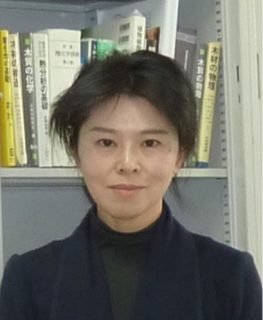
Professor Yukie SAITO in IPADS is a forerunner in research on plant materials as well as one of the leading researchers on the future of carbon material science. She talks about her discipline, Global Plant Material Science, from an agricultural perspective, and her strategies for supervising students.
After graduating from Kyoto University, out of the Department of Forest Products Research, Faculty of Agriculture, she completed her MSc and PhD degree at the University of Tokyo, in the Graduate School of Agricultural Life Sciences, Department of Biomaterial Science. In 2008, she became an associate professor in the Department of Global Agricultural Sciences/International Program in Agricultural Development Studies (IPADS). In April 2018, she assumed the post of professor for the same course.
As a discipline rooted in Agricultural Sciences, we take an approach from an agricultural point of view, taking into consideration environmental and social aspects in order to tackle the issues of the current world by utilizing globally available plant materials.
The aim of Global Plant Material Science is to pursue opportunities offered by plant materials, using science and technology from the 21st century. At the same time, as a discipline within the IPADS and the Faculty of Agriculture, Global Plant Material Science is deeply grounded in ecological systems and our society.
Historically, humans have been able to materialize conceptual ideas to make them real. We have developed tools and infrastructure, using diverse materials, in order to protect us from harsh environmental conditions and make our own living environment viable, safe, and prosperous. Throughout the development of our civilization, materials have played an important role and continue to do so. We can explore our ideas to create something useful for human life using materials that are abundant and always available in our living environment. However, choosing the right material for further usage is very important in the modern world. Primarily, these materials should have qualities suitable to transform ideas into reality. In current world, it is important that these materials present 1) no burdens on the environment and 2) a sustainable supply in the material life cycle, at each stage of material sampling, processing, use, and future disposal.
Historically, wood and other plant materials have been used as principal resources for creating products. However, in the 20th century, it became possible to synthesize substances from raw materials derived from fossil resources. At this point, plastic replaced the wood and other plant materials as a primary resource for making products indispensable for our daily life, such as containers, clothing, furniture, and more. More recently, however, we have begun to understand that fossil resources are limited.
There are many valuable pharmaceutical compounds that can only be manufactured from fossil resources. Therefore, it is important to consider these resources as precious resources that need to be conserved for our future. It is estimated that, worldwide, the energy equivalent of 10 billion tons of oil is used annually, while 80 billion tons of biomass is produced in forests and grasslands annually. In fact, there has been a push to utilize plant materials for development, as we have in the past. This does not mean that we go back to the past, but instead, we can become pioneers in developing future materials from plants, by using modern science and technology.
Advanced science and technology is essential in order to assess plants for use as materials. Unlike animals, plants cannot move by themselves, and have acquired mechanisms to protect themselves from environmental changes and external enemies throughout the course of 100 million years of evolution. For example, plant cell walls are reinforced with high-strength fibers, creating a multilayered composite structure that can withstand forces from all directions, similar to the structure and strength of ski boards at nano-scale, or 1/1000 of a ski board. An amazingly delicate and solid structure does not allow manipulation as easily as other materials, allowing for prolonged human usage. In the end, the aim of the Global Plant Material Science is to search for new possibilities offered by plant materials, using science and technology from the 21st century.
Importance of foundations and applications: Choosing suitable material for research from the viewpoint of Agricultural sciences
There are a lot of unanswered questions, such as the fundamentals of how the organizational structure and component characteristics of plant cell walls respond to changing conditions such as heat, moisture, and other physicochemical actions. Fundamental research into plant mechanisms are important, and based on research, we can discover new functions, drawn from, and applied to, plants.
It is important to choose a suitable research subject among the multitude of plants in existence. From an agricultural point of view, unused plant residue that has been abandoned after mass production can cause harm to the environment. This is an issue that needs to be solved urgently and is considered as a good research subject. For example, rice husk is a good research subject, because in some areas, rice husks are dumped into rivers, causing harm to the environment. This is due to properties that make it difficult to be incorporated or composted when returned to the field. Other examples include abandoned bamboo trees that have overgrown and invaded rice fields, or large numbers of old oil palm trees that have been discarded after oil collection.
Please refer to our laboratory website for further information about these research subjects.
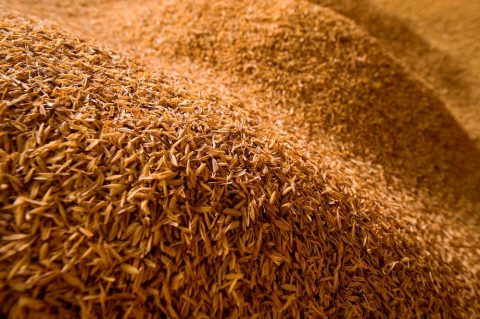
Rice Husk Image source: Wikipedia
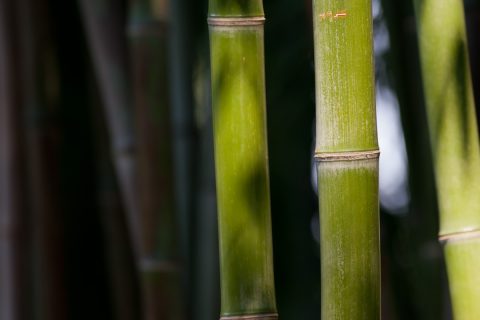
https://commons.wikimedia.org/w/index.php?curid=17996261
For those who intend to enter into IPADS and study Global Plant Material Science
IPADS MSc students typically chose a supervisor/laboratory and engage in full-time research after a six-month period of coursework. In case of my laboratory, the laboratory of Global Plant Material Science, you are welcome to visit us, see our activities and discuss research subjects with me anytime. We have set five fundamental research themes:
- Technology development in under-utilized plant resources.
- Studying the function of plant components in ecosystems.
- Developing techniques for performance evaluation of lesser-used biomass resource materials.
- The effective utilization of lignin and other chemicals from wood materials.
- Wood-based building materials and components.
However, it is up to the students to explore their research themes. There are students who have already decided on their research subjects as they enter my laboratory, such as, the application of cellulose nanofibers from bamboo. Others do not have any idea what to do or may have a huge project that is unlikely to be completed before graduation, so do not worry too much.
My strategy for these cases is to discuss options with students, while doing preliminary experiments together. I want to inspire students to find their way in getting to know their interests and research theme on their own by moving their hands, thinking, and acting in the real world. It is an important process to go through in order to broaden and deepen research goals.
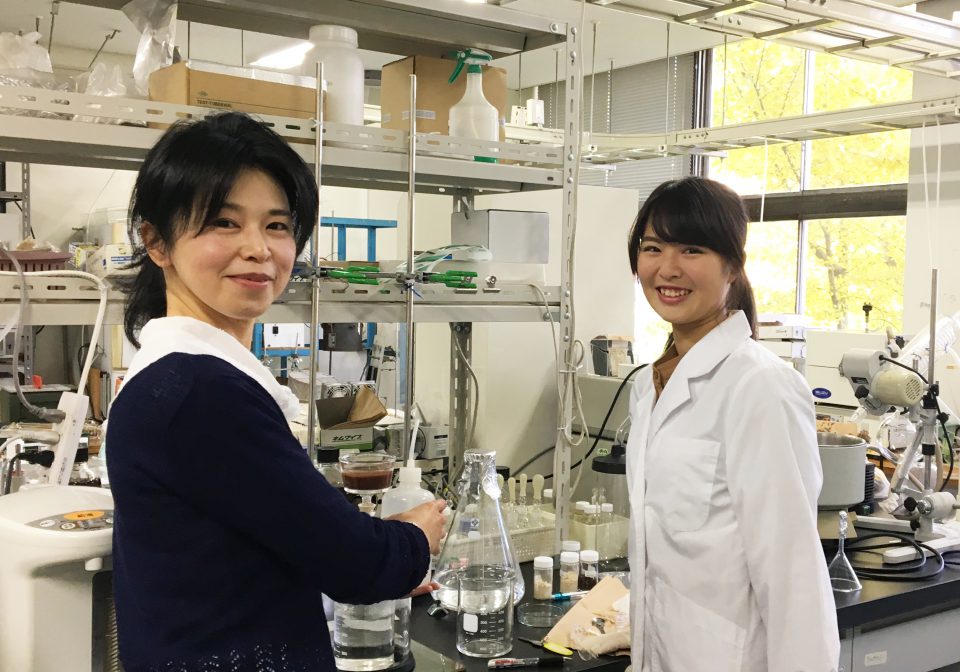
Dr. Saito at her laboratory
Journey to MSc thesis
Currently, I am supervising three students in my laboratory: one Chinese research student and two 4th year undergraduate Japanese students. Our undergraduate students are working on the functionalization of rice husk through heat treatment and the effective utilization of waste residue for cacao pods. The research student is doing research on sugarcane.
We also had two IPADS MSc students who recently graduated: Florence Lui (Manufacturing binderless boards from Oak logs used for Shiitake mushroom cultivation) who graduated in 2017, and Mai-Mari Hirose Carlsen (Prevention of Crystallisation of Silicon Oxide upon Combusting Rice Husk) who graduated in 2018.
Florence focused on oak logs used for shiitake cultivation, agricultural residues that could be recycled for use as resources. Wood chips can be glued together and used as inner boards in furniture. However wood chips themselves contain “self-adhesive” components, which do not require glue. Her studies discovered that this self-adhesive force works well in wood decomposed moderately by shiitake mushrooms. She also analyzed the mechanism for how shiitake mycelium transforms wood into high-strength boards. (see reference paper : Florence Lui, Yoko Kurokochi, Hiroe Narita, Yukie Saito, Masatoshi Sato, The effects of chemical components and particle size on the mechanical properties of binderless boards made from oak (Quercus spp.) logs degraded by shiitake fungi (Lentinula edodes), Journal of Wood Science, 66, 246-245, 2018)
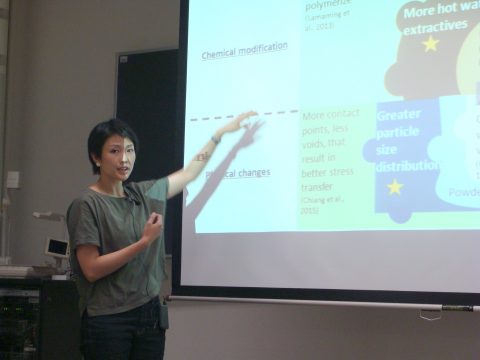
She enthusiastically learned requisite concepts and lab skills, despite majoring in social sciences for her undergraduate studies.
The learning curve was steep, but, nevertheless, as a result of her countless efforts and patience in the lab work, her skills improved dramatically, and she told me that she found the lab work more and more enjoyable.
Mai-Mari entered my laboratory with firm intentions to study the effective utilization and distribution of rice husks. After entering to my laboratory, she spent the first six months to a year thinking about her research proposal, and eventually, she got a clearer image of a research topic and objectives. In the end, she worked on it intensively and completed it in about half a year or so.
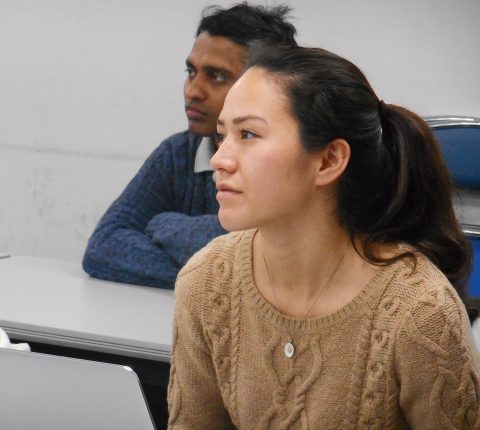
at course work
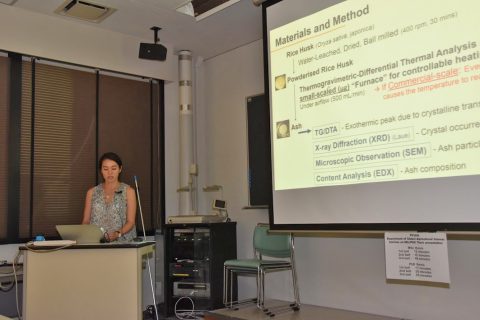
Mai-Mari presenting her MSc thesis
During the period she was searching for a more defined research topic, she participated in key field work in Ogata village in Akita prefecture with me. There, the land was reclaimed from a lake and shaped into paddy fields through government initiatives, in order to solve the post-war food shortage in Japan, where farmers were recruited to conduct intensive rice cultivation. Ogata village generates a large amount of rice husks due to rice production, one of the reasons was why we thought it was important to conduct a field work there. In addition, people in Ogata village had a keen interest in natural biomass energy because the village is located at sea level and energy is continuously consumed on water drainage.

The reclamation land in Oogata Village (image source: Ootaga Village Official Website)
While visiting the site and interviewing the mayor in Ogata village, her interest in the use of rice husk as an energy source transformed from a vague concept, to become a concrete research theme. She finally focused on the fundamental research to tackle the problem of silica, a component of rice husk which hinders burning. Her research has precisely clarified the behaviour of silica by focusing not only on its combustion temperature, but also on the rate of reaction. I am convinced that her research contributes to exploring safe rice husk combustion methods. (She was awarded an excellent presentation prize at the Wood Carbonization Research Society of Japan by this work. Also, she is currently writing a contributing paper).
After graduating from the laboratory of Global Plant Materials Science in IPADS
Almost half of the graduates took jobs requiring research expertise in laboratory work. However, I think that the experience of spending time as a “researcher” and performing laboratory work will be useful for the future even for those getting employed in fields not directly related to research. For example, Mai-Mari got a job at a foreign-affiliated manufacturer. Although her current position is not as a researcher, she seems to be acquiring good knowledge of electric circuitry for natural energy power generator equipment handled by the manufacturer, as is required for her position. I understand that she had worried about making the wrong interpretation of data issued without understanding the function and action of the equipment apparatus “mechanism” during her master’s research experiments in my laboratory. This is why she knows the importance of understanding fundamentals of the operation. I firmly believe that the profound insight that she had acquired through lab work becomes a source for her successful future career in a new field.
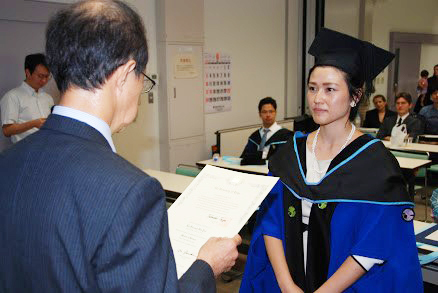
Florence at her graduation
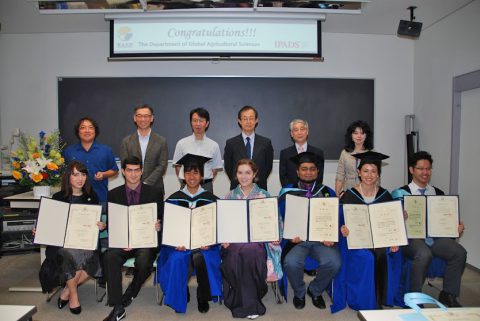
Meanwhile, Florence decided to advance into a PhD course at her home country, majoring in materials science, and started a career as a natural scientist. Prior to her enrollment to IPADS, she worked in a business/financial environment and her primary purpose for entering our laboratory was to learn biomass utilization knowledge for her future career in the development sector. However, she became increasingly interested in scientific research as she was exposed to the natural sciences after entering IPADS and my laboratory. Once I was impressed by her saying, “natural science is patient study”. Patience is always crucial in each task, such as collecting evidence on the way to prove one fact in natural science. You have to build skills to get your experiment to run properly. Literature review does not directly answer all your questions. She said she liked how the subject required interdisciplinary work.

In conclusion, the growth of our civilization in the last century was deeply related with the development of science & technology. Again, I am certainly convinced that knowledge and attitude acquired through intense research experiences in natural science studies can help students to build themselves up after graduation. If you like to use your hands or to do lab work, you are welcome in my laboratory.
<The interview was conducted by Noriko FUJIMOTO, IPADS Office>